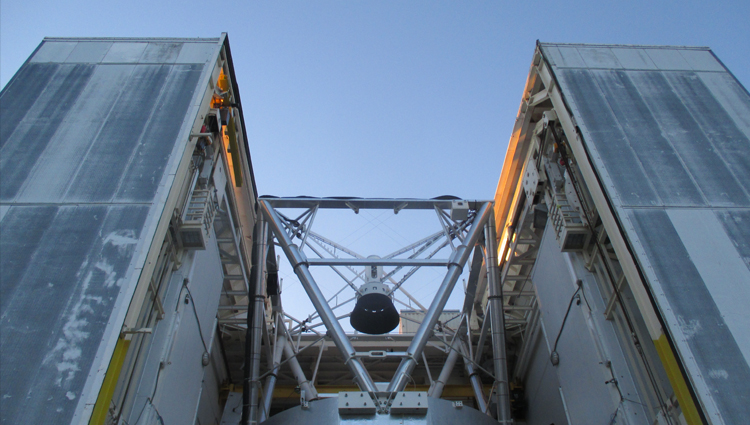Arizona Telescope's Wide Angle Images Rival Hubble's

WASHINGTON (ISNS) -- Look to the night sky above Arizona's Mount Hopkins, and you can faintly make out five beams of green laser light stretching from the peak to the stars above.
These newly-installed lasers help to enhance the sight of the aging MMT telescope, giving it capabilities that rival those of the Hubble Space Telescope and a new seat among the largest telescopes in the world.
The MMT Telescope can now see a wider area of sky than Hubble's near-infrared camera in just as much detail and detect shades of infrared invisible to Hubble. Thanks to its superior size, the MMT can also potentially detect fainter objects farther away.
"We've opened up a unique capability that isn't out there right now," said Michael Hart of the University of Arizona in Tucson. "And we've given new life to an old facility."
When installed in 2000, MMT's 6.5-meter (21-foot) mirror was the largest single telescope mirror in the continental United States. Astronomers have used it to confirm the presence of water on the moon and to discover new black holes, galaxies, and planets outside of our solar system.
Today, the telescope is on the small side of the world's biggest telescopes, many of which use mirrors more than 10 meters (33 feet) in diameter. Bigger mirrors collect more light, allowing astronomers to see fainter objects and to take faster snapshots of bright objects.
But even with large mirrors, ground-based telescopes are hampered by the Earth's atmosphere, which blurs light and smears images. That's why space telescopes can get away with smaller mirrors -- Hubble's measures only 2.4 meters (8 feet) across.
Adaptive optics systems, like the new lasers at MMT, help observatories around the world to overcome this shortcoming. They typically use a light from a "guide star" -- a natural star close to the area of interest or a custom-made laser shot into sky -- to measure and correct for the effects of turbulence in the atmosphere. An adaptive optics system at the world's largest telescope, the Large Binocular Telescope on Arizona's Mount Graham, improves image quality by roughly a factor of 80.
"Traditional adaptive optics is like looking at the sky through a soda straw," said Claire Max, an astronomer at the Lick Observatory at the University of California, Santa Cruz. "You're only correcting a very small area, but you're correcting it very well."
By using five laser guide stars instead of one, the MMT team's ground-layer adaptive optics -- the first of its kind -- widened that straw.
"Ground-layer adaptive optics will get you a more moderate benefit over a larger area of sky," said Chris Shelton, who designs adaptive optics systems at NASA's Jet Propulsion Laboratory in Pasadena, Calif.
MMT's new system boosts its resolution by a factor of only two or three, according to results published Wednesday in the scientific journal Nature. But the improvement is uniform over an area of sky about one-fifteenth the size of a full moon -- two arc minutes, to astronomers.
Max called this uniformity the "holy grail" of adaptive optics.
To achieve this effect, the laser beams -- which are the same color as a green laser pointer -- are arranged in a pentagon and shot 18 miles high into the sky. A sensor records the light that scatters and bounces back from the atmosphere; two more sensors gather light from a natural star. The combined information from these three sensors is used to bend a small secondary mirror four hundred times per second to erase distortions in the light detected by the telescope.
"This is an important advance for the MMT," said Brent Ellerbroek of the Thirty Meter Telescope project at Mauna Kea Observatory in Hawaii. "They can point this pretty much anywhere they want to in the sky."
Astronomers at the MMT aimed their upgraded telescope at M3, a star cluster about 35,000 light-years from Earth. The wide-angle view captured the entire cluster in one shot, cutting down on the observation time. This speed could help astronomers to quickly identify and catalog stars in clusters.
"We want to use this new system to test arguments about how stars form," said Hart, who also wants to take a closer look at the stars orbiting the black hole at the center of our galaxy.
Hart, who is working on a similar system for the Large Binocular Telescope, hopes that the technology provides pointers for other teams developing multiple guide star systems for the extremely large telescopes of the future, such as the Thirty Meter Telescope in Hawaii and the Giant Magellan Telescope planned for Chile.
"These new telescopes will cost a billion dollars each," said Hart. "If you're going to spend that much money building a scientific instrument, you need use adaptive optics to get every scrap of science out of it."

